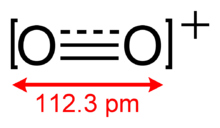Dioxygenyl

The dioxygenyl ion, O+
2, is a rarely-encountered oxycation in which both oxygen atoms have a formal oxidation state of + 1⁄2. It is formally derived from oxygen by the removal of an electron:
- O2 → O+
2 + e−
The energy change for this process is called the ionization energy of the oxygen molecule. Relative to most molecules, this ionization energy is very high at 1175 kJ/mol.[1] As a result, the scope of the chemistry of O+
2 is quite limited, acting mainly as a 1-electron oxidiser.[2]
Structure and molecular properties
O+
2 has a bond order of 2.5, and a bond length of 112.3 pm in solid O2[AsF6].[3] It has the same number of valence electrons as nitric oxide and is paramagnetic.[4] The bond energy is 625.1 kJ mol−1 and the stretching frequency is 1858 cm−1,[5] both of which are high relative to most molecules.
Synthesis
The reaction of oxygen, O2, with platinum hexafluoride, PtF6, yields dioxygenyl hexafluoroplatinate, O2[PtF6]:
- O2 + PtF6 → O+
2[PtF
6]−
PtF6 is one of the few oxidising agents sufficiently powerful to oxidise O2.
Dioxygenyl hexafluoroplatinate played a pivotal role in the discovery of noble gas compounds. After Neil Bartlett found that PtF6 could oxidise O2 to O+
2, he investigated its reaction with noble gases and discovered xenon hexafluoroplatinate.
O+
2 is also found in similar compounds of the form O2MF6, where M is arsenic (As), antimony (Sb),[6] gold (Au),[7] niobium (Nb), ruthenium (Ru), rhenium (Re), rhodium (Rh),[8] vanadium (V),[9] or phosphorus (P).[10] Other forms are also attested, including O2GeF5 and (O2)2SnF6.[9]
The tetrafluoroborate and hexafluorophosphate salts may be prepared by the reaction of dioxygen difluoride with boron trifluoride or phosphorus pentafluoride at −126 °C:[10]
- 2 O2F2 + 2 BF3 → 2 O2BF4 + F2
- 2 O2F2 + 2 PF5 → 2 O2PF6 + F2
These compounds rapidly decompose at room temperature:
- 2 O2BF4 → 2 O2 + F2 + 2 BF3
- 2 O2PF6 → 2 O2 + F2 + 2 PF5
Reactions
The reaction of O2BF4 with xenon at 173 K produces a white solid believed to be F–Xe–BF2, containing an unusual xenon-boron bond:[11]
- 2 O2BF4 + 2 Xe → 2 O2 + F2 + 2 FXeBF2
The dioxygenyl salts O2BF4 and O2AsF6 react with carbon monoxide to give oxalyl fluoride, C2O2F2, in high yield.[12]
References
- ↑ Michael Clugston; Rosalind Flemming (2000). Advanced Chemistry, Oxford University Press, ISBN 0-19-914633-0, ISBN 978-0-19-914633-8, p. 355.
- ↑ Foote, Christopher S.; Valentine, Joan S. (1995). Active oxygen in chemistry. Joel F. Liebman, A. Greenberg. Springer. ISBN 0-412-03441-7.
- ↑ Greenwood, Norman N.; Earnshaw, Alan (1997). Chemistry of the Elements (2nd ed.). Butterworth-Heinemann. ISBN 0-08-037941-9. p. 616
- ↑ Cotton, F. Albert; Wilkinson, Geoffrey; Murillo, Carlos A.; Bochmann, Manfred (1999), Advanced Inorganic Chemistry (6th ed.), New York: Wiley-Interscience, ISBN 0-471-19957-5
- ↑ J. Shamir; J. Binenboym; H. H. Claassen (1968). "The vibrational frequency of the O2+ cation". J. Am. Chem. Soc. 90 (22): 6223–6224. doi:10.1021/ja01024a054.
- ↑ A. R. Young; T. Hirata; S. I. Morrow (1964). "The Preparation of Dioxygenyl Salts from Dioxygen Difluoride". J. Am. Chem. Soc. 86 (1): 20–22. doi:10.1021/ja01055a006.
- ↑ Nakajima, Tsuyoshi (1995). Fluorine-carbon and fluoride-carbon materials: chemistry, physics, and applications. CRC Press. ISBN 0-8247-9286-6.
- ↑ Vasile, M. J.; Falconer, W. E. (1975). "Vapour transport of dioxygenyl salts". Journal of the Chemical Society Dalton Transactions (4): 316–318. doi:10.1039/DT9750000316.
- 1 2 Holleman, Arnold F.; Wiberg, Egon (2001). Inorganic chemistry. Academic Press. p. 475. ISBN 0-12-352651-5.
- 1 2 Solomon, I. J.; Brabets, R. I.; Uenishi, R. K.; Keith, J. N.; McDonough, J. M. (1964). "New Dioxygenyl Compounds". Inorganic Chemistry. 3 (3): 457. doi:10.1021/ic50013a036.
- ↑ Goetschel, C. T.; Loos, K. R. (1972). "Reaction of xenon with dioxygenyl tetrafluoroborate. Preparation of FXe-BF2". Journal of the American Chemical Society. 94 (9): 3018–3021. doi:10.1021/ja00764a022.
- ↑ Pernice, H.; Willner, H.; Eujen, R. (2001). "The reaction of dioxygenyl salts with 13
CO Formation of F13
C(O)13
C(O)F". Journal of Fluorine Chemistry. 112 (2): 277–590. doi:10.1016/S0022-1139(01)00512-7.